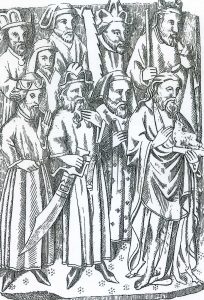The Norwich Te Deum Altarpiece may once have belonged to the Chapel in the Fields where the Assembly Rooms now stand. The Hospital and Chapel were surrendered to Henry VIII in 1544 and completely destroyed soon afterwards. Five sections of the Altarpiece survived and in late 2013 they were reunited for the first time in hundreds of years for the Sainsbury Centre’s exhibition Masterpieces: Art and East Anglia.
(from the 1662 Te Deum)
1) MOSES carries his staff in his right hand, and fragments of the stone tablets in his left. The round horns on his head are due to a mistranslation in the Latin Vulgate version of the Bible; the Hebrew word for radiant is similar to the word for horn.
When Aaron and all the Israelites saw Moses his face was radiant, and they were afraid to come near him. (Exodus 34: 30)
2) ISAIAH traditionally carries a saw. In the Jerusalem Talmud (Sanhedrin x), the prophet, afraid for his life, concealed himself in a cedar tree. Alas, the fringes of his robe remained visible and Judah’s evil King Manasseh commanded his servants to saw the tree in half.
3) This may be ELIJAH, wearing the prophet’s cloak which Elisha was soon to inherit.
Elijah went up to heaven in a whirlwind… Elisha… picked up the cloak that had fallen from Elijah… and struck the water with it. “Where now is the Lord, the God of Elijah?” he asked. When he struck the water it divided to the right and to the left, and he crossed over. (2 Kings 2: 13-14)
4 3 2 1

5 6 7 8 9
Jeremiah… one of the priests at Anathoth in the territory of Benjamin. (Jeremiah 1:1)
7) DAVID has a forked beard and carries the curved scimitar sword of his arch-enemy Goliath.
So David triumphed over the Philistine with a sling and a stone; without a sword in his hand he struck down the Philistine and killed him… He took hold of the Philistine’s sword and drew it from the scabbard. After he killed him, he cut off his head with the sword. (1 Samuel 17: 50-51)
8) This may be DANIEL. Traditionally of royal descent, he wears “royal” robes and carries a scroll.
“But you, Daniel, roll up and seal the words of the scroll until the time of the end.” (Daniel 12:4)
9) JOHN THE BAPTIST
The bare-headed John carries a book to represent the Word of God. His eyes gaze downwards and his hand points tenderly to the Lamb of God.
“Look, the lamb of God who takes away the sin of the world!” (John 1: 29)
